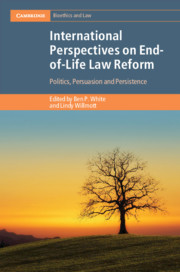Book contents
- International Perspectives on End-of-Life Law Reform
- Cambridge Bioethics and Law
- International Perspectives on End-of-Life Law Reform
- Copyright page
- Contents
- Preface
- About the Editors
- List of Contributors
- Table of Cases
- Table of Statutes, Bills and Regulations
- 1 End-of-Life Law Reform
- 2 The Path from Rodriguez to Bill C-14 and Beyond
- 3 The Extension of the Belgian Euthanasia Law to Minors in 2014
- 4 The Role of Scientific Evaluations of the Dutch Termination of Life on Request and Assisted Suicide (Review Procedure) Act
- 5 The Challenging Path to Voluntary Assisted Dying Law Reform in Australia
- 6 Should Assisted Dying Require the Consent of a High Court Judge?
- 7 Aid in Dying in the United States
- 8 The Medical Regulator as Law Reformer
- 9 Extrajudicial Resolution of Medical Futility Disputes
- 10 Challenging Mandatory Court Hearings for People in Vegetative and Minimally Conscious States
- 11 Withholding and Withdrawing Life-Prolonging Treatment and the Relevance of Patients’ Wishes
- 12 International Perspectives on Reforming End-of-Life Law
- Index
7 - Aid in Dying in the United States
Past, Present and Future
Published online by Cambridge University Press: 02 December 2021
- International Perspectives on End-of-Life Law Reform
- Cambridge Bioethics and Law
- International Perspectives on End-of-Life Law Reform
- Copyright page
- Contents
- Preface
- About the Editors
- List of Contributors
- Table of Cases
- Table of Statutes, Bills and Regulations
- 1 End-of-Life Law Reform
- 2 The Path from Rodriguez to Bill C-14 and Beyond
- 3 The Extension of the Belgian Euthanasia Law to Minors in 2014
- 4 The Role of Scientific Evaluations of the Dutch Termination of Life on Request and Assisted Suicide (Review Procedure) Act
- 5 The Challenging Path to Voluntary Assisted Dying Law Reform in Australia
- 6 Should Assisted Dying Require the Consent of a High Court Judge?
- 7 Aid in Dying in the United States
- 8 The Medical Regulator as Law Reformer
- 9 Extrajudicial Resolution of Medical Futility Disputes
- 10 Challenging Mandatory Court Hearings for People in Vegetative and Minimally Conscious States
- 11 Withholding and Withdrawing Life-Prolonging Treatment and the Relevance of Patients’ Wishes
- 12 International Perspectives on Reforming End-of-Life Law
- Index
Summary
Until Oregon voters approved an aid-in-dying referendum in 1994, no jurisdiction in the United States had given legal approval to aid in dying. Moreover, fourteen years passed before a second state, Washington, legalised aid in dying. Since then, recognition has accelerated. Now, aid in dying is permitted in nine states and the District of Columbia, with nearly one in four Americans living in a jurisdiction that permits the practice. While a right to aid in dying has taken different paths—voter approval, legislative action, or judicial decision—all legalising US jurisdictions recognise the right in the same basic way: patients must be adults with decision-making capacity, must be terminally ill, and must self-administer the lethal dose of medication. This chapter discusses why the different jurisdictions have converged on the same legal framework for a right to aid in dying. In particular, there are key reasons for limiting a right to aid in dying to patients who are terminally ill (i.e., life-expectancy of six months or less). The chapter also discusses the implications of the common legal framework for future evolution of the right to aid in dying in the United States.
Keywords
- Type
- Chapter
- Information
- International Perspectives on End-of-Life Law ReformPolitics, Persuasion and Persistence, pp. 145 - 164Publisher: Cambridge University PressPrint publication year: 2021

